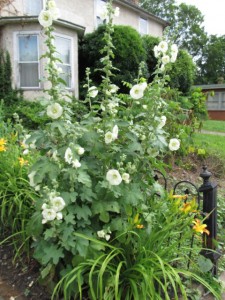Hollyhocks (Alcea rosea) are old-fashioned perennials (and biennials) which are currently finding a new audience. There are numerous cultivars differing in plant height from 5 to 9 feet and spread of 1 to 3 feet. Flowers come in single and double forms and in many color shades. Hollyhocks are hardy to USDA hardiness zone 4.
Hollyhocks are short-lived perennials and want full sun and moist, rich, well drained soil. Sow the seeds outside about a week before last frost. If you are planting seedlings outdoors, wait until 1-2 weeks after the last expected spring frost. Hollyhock seeds only need to be sown shallow, no more than 1/4 of an inch deep. Hollyhock transplants should be set 3 feet apart.
Hollyhock rust is a destructive leaf disease common in Southern Appalachian and Northeast U.S. gardens (USDA zones 5 -7). Symptoms of hollyhock rust are orange-brown spots on foliage and stems. The orange-red spores are splashed by rain or overhead watering or blown by wind to nearby leaves, starting new infections all spring and summer long. In severe cases infected leaves turn brown and shrivel up.
Tips on reducing hollyhock rust include: 1. Purchase only healthy disease-free plants; 2. Prune back all plant debris to the ground in the autumn to reduce overwintering of the disease spores; 3. Remove any weeds related to the mallows; 4. Space plants 3 or more feet apart in a sunny location; 5. Water and fertilize to maximize plant growth. Avoid overhead watering and remove all rust-spotted leaves.
Rust can be severe in a wet growing year. Daconil 2787 (chlorothalonil), mancozeb (e.g. Fore, Dithane, or Penncozeb), trifloxystrobin (Compass®), or myclobutanil (Systhane®) can prevent severe hollyhock rust outbreaks. Fungicides can protect but not cure leaves with rust symptoms.
A final tip comes from Allen Bush with Jelitto Seed in Louisville, KY. He recommends cutting back the newly emerged hollyhock plants (back to the ground) in late April. Healthy hollyhocks will rapidly re-grow in the drier warm weather in late spring and summer. Hollyhock is one of the first garden perennials to emerge in the spring when the weather is generally wet and cool when the threat of rust is most severe.


 Posted in
Posted in 
